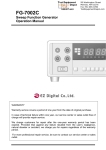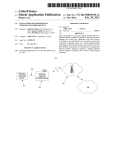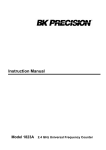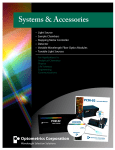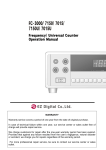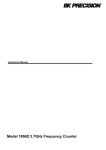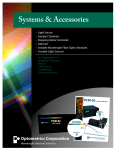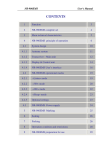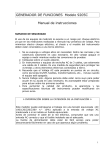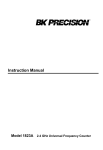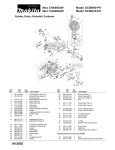Download FG-7005C
Transcript
99 Washington Street Melrose, MA 02176 Fax 781-665-0780 TestEquipmentDepot.com FG-7005C Sweep Function Generator Operation Manual 88 88 1-1. Introduction This instrument is the Most Versatile Signal Source used as FUNCTION GENERATOR, SWEEP GENERATOR, PULSE GENERATOR and a FREQUENCY COUNTER, offering a wide range of applications in both analog and digital electronics such as engineering, manufacturing, servicing, education and hobbyist fields. VCF(voltage controlled frequency) produces precision sine, square and triangle waves over the 0.05 Hz to 5 MHz for sub-audible, audio, ultrasonic and RF applications. A continuously variable DC offset allows the output to be injected directly into circuits at the correct bias level. Variable symmetry of the output waveforms converts the instrument to a pulse generator capable of generating rectangular waves or pulses, ramp or sawtooth waves and skewed sine waves of variable duty cycle. The sweep generator offers linear sweep with variable sweep rate and sweep width up to 100:1 frequency change. The frequency response of any active or passive device up to 5 MHz can be determined. 1-2. Technical Specifications OUTPUT CHARACTERISTICS Waveforms : Sine, Square, Triangle, Ramp, Pulse, Sawtooth, TTL/CMOS Leveled Square, DC Frequency Range : 0.05 Hz to 5 MHz in 7 Range(1,10,100,1K,10K,100K,1M) Frequency Accuracy : ± 5% (1,10,100,1K,10K,100K,1MHz Range ) (Full Scale) Output Level : 20 Vp-p in open circuit, 10 Vp-p into 50 Ω Load Output Impedance : 50 Ω ± 5% Attenuator : 20 dB fixed and continuously variable WAVEFORM CHARACTERISTICS Sine wave -Flatness : ± 2.5V to 5 MHz -Distortion : Less than 1% at 0.5 Hz to 100 KHz Square wave -Rise and Fall Time : Less than 25 nS Triangle wave -Linearity : More than 99% at 0.2 Hz to 100 KHz TTL Output -Rise and Fall time : Less than 25 nS -Output Level : TTL Level(H 2.4V, L 0.4V) CMOS Output -Rise and Fall Time : Less than 150 nS(Max. Out) (DC – to 2MHz) -Output Level : 4V to 15V ± 1V, Variable DUTY RATIO : 1:1 to 10 : 1 Test Equipment Depot - 800.517.8431 - 99 Washington Street Melrose, MA 02176 FAX 781.665.0780 - TestEquipmentDepot.com SWEEP FUNCTION CHARACTERISTICS Mode : Linear Width : Variable from 1 : 1 to 100 : 1 Rate : 0.5 Hz to 50 Hz (20 mS to 2 S) External VCF Input : Input Voltage : 0 to 10 V Input Impedance : Approx. 10 KΩ FREQUENCY COUNTER CHARACTERISTICS Display : 6 digit green LED, Gate time, MHz, KHz, Hz, mHz. Frequency Range : 500 mHz to 50 MHz With Auto Range. Accuracy : ± Time base Error ± 1 count Time base : 10 MHz Input Sensitivity : 100 mVrms Max. Input Voltage : 250 Vp-p DIMENSION AND WEIGHT Dimension : 255(W)x 255(D) x90(H)mm Weight : Approx. 2.0Kg 1-3. Equipment Ratings Input Voltage Fuse Power Max. 103 126V AC(50/60Hz) F 0.5A 250V 15W 206 252V AC(50/60Hz) F 0.25A 250V 15W Operating Environment TEMPERATURE : 0 ° C to + 40 ° C HUMIDITY :up to 85% to 40° C without temperature extremes causing condensation within the instrument. Storage Environment TEMPERATURE : -20° C to +70° C HUMIDITY : below 85% RH Insulation Category II : Portable equipment of local level. Pollution Degree :2 Protection to IEC 529 : Ordinary Test Equipment Depot - 800.517.8431 - 99 Washington Street Melrose, MA 02176 FAX 781.665.0780 - TestEquipmentDepot.com 1-4. Supplied Accessories User’s Manual ---------------------------------------------------------------------------- 1 BNC Cable ------------------------------------------------------------------------------ 1 Power Cord -----------------------------------------------------------------------------Spare Fuse ------------------------------------------------------------------------------- 1 1 specifications are subject to change without notice. Test Equipment Depot - 800.517.8431 - 99 Washington Street Melrose, MA 02176 FAX 781.665.0780 - TestEquipmentDepot.com 2. INSTALLATION 2-1. Initial Inspection This instrument was carefully inspected both mechanically and electrically before shipment. It should be physically free of damage. To confirm this, the instrument should be inspected for physical damage in transit. Also, check for supplied accessories. 2-2. Connecting AC Power This instrument requires AC 230V/115V,50-60Hz power through 3-conductor ac power cable to be fit into three-contact electrical outlet to secure grounding. If forced to use 2-conductor cable, use ground terminal in rear panel for grounding instrument. CAUTION THIS INSTRUMENT IS SET TO AC 230V. BEFORE POWERING ON THIS INSTRUMENT, MAKE SURE THE VOLTAGE OF THE POWER SOURCE IS AC 230V. IN CASE OF AC115V, SWITCH SHOULD BE SELECTED DOWN TO 115V POSITION. 2-3. Cooling And Ventilation No special cooling and ventilation is required. However, the instrument should be operated where the ambient temperature is maintained. 2-4. Position This instrument is built as a bench-type instrument with rubber feet and tilt stand in place. Stand-up angle can be adjusted by rotating angle of carrying handle. 2-5. WARMING-UP Allow more than 20 minutes for the unit to warm up so that it is stabilized and ready for use. Test Equipment Depot - 800.517.8431 - 99 Washington Street Melrose, MA 02176 FAX 781.665.0780 - TestEquipmentDepot.com 3. OPERATION 3-1. Controls, indicators and connectors FIG 1. FRONT PANEL OPERATOR’S CONTROLS LED DISPLAY. INTERNAL/EXTERNAL SWITCH. RANGE SWITCHES. FUNCTION SWITCHES. ATTENUATOR. GATE TIME INDICATOR. FREQUENCY DIAL. MHz, KHz , Hz, mHz INDICATOR. EXTERNAL COUNTER INPUT BNC. SWEEP RATE CONTROL. SWEEP WIDTH CONTROL. Displays Internal Or External Frequency. PUSH IN : External Frequency Counter. PUSH OUT: Internal Frequency Counter. Frequency Range Selector. Select Sine wave, Triangle Wave Or Square Wave Output. Selects Output Level By -20 dB. Gate Time Is Selected Automatically By Input Signal. Controls Output Frequency In Selected Range. Indicates Unit Of Frequency. Used As An External Frequency Counter. On-Off Switch For Internal Sweep Generator, Adjusts Sweep Rate Of Internal Sweep Generator. Pullout And Adjusts Magnitude Of Test Equipment Depot - 800.517.8431 - 99 Washington Street Melrose, MA 02176 FAX 781.665.0780 - TestEquipmentDepot.com Sweep. Voltage Controlled Frequency Input Permits External Sweep. Frequency Control Sweep Rate Control Should Be Off When Applying External Voltage At This BNC. Adjust Symmetry Of Output Waveform 1:1 to 10:1 With Push/Pull Switch On. Selects TTL Or CMOS Mode Pull-out : CMOS Level Control, PushIn: TTL Level. TTL/CMOS Level Output. Adds Positive Or Negative DC Component To Output Signal. Impedance 50 Ohm. Adjusts Output Level From 0 TO -20 dB. Pull Out To Adjust Tilt. Push type switch. turning on the power when pressed. VCF INPUT BNC. SYMMETRY CONTROL. TTL/CMOS CONTROL. TTL/CMOS OUTPUT BNC. DC OFFSET CONTROLS. MAIN OUTPUT BNC. AMPLITUDE CONTROL. TILT STAND. POWER SWITCH. VOLTAGE 115V 230V FUSE 0.5AF 0.25AF POWER MAX 10W 10W SN : 115V 22 230V 21 FIG 2. REAR PANEL FUSE HOLDER. Replacing fuse with unscrewing AC INLET. For connection of the supplied AC power Test Equipment Depot - 800.517.8431 - 99 Washington Street Melrose, MA 02176 FAX 781.665.0780 - TestEquipmentDepot.com 3-2. Operating instruction This instrument is capable of generating a wide variety of waveforms and counting an external frequency with high resolution of 6 digits LED. The most benefit and satisfaction can be gained from the instrument by fully understanding its capabilities and versatility and becoming familiar with operation procedure. One of the best ways to initially gain this familiarization is to connect the generator to an oscilloscope. Observe the waveforms and notice the effects of the various controls on the waveforms. Use this manual as a reference until becoming accustomed to operating procedures. 3-3. Use As Function Generator. 3-3-1. Procedure A. Connect AC power cord into receptacle on rear panel and plug into AC inlet. B. To turn on equipment, push power on-off switch on. C. To make sure that the output is symmetrical and unaffected by the sweep generator, set the following controls as below. CONTROLS POSITION Sweep width OFF(push) Symmetry OFF(push) DC offset OFF(push) Attenuator RELEASE(button out) Counter INTERNAL(button out) D. To select the desired frequency, set the Range Switch and FREQ. dial as follows; The output frequency equals the FREQ. dial setting multiplied by the Range Switch setting. For example, a FREQ. dial setting of 0.6 and a Range switch setting of 10K produces a 6 KHz output(.6x10 = 6K). A FREQ. dial setting of 5.0 and a Range switch setting of 1M produces 5 MHz output(5.0x1M = 5M). E. And also it can display the desired frequency by 4 digit LED display. F. Select sine, square, or triangle wave output by pressing the corresponding FUNCTION button. FIG 3. illustrates the output waveforms and their phase relationships. G. Connect a cable from the 50Ω BNC to the point where it is desired to inject the signal. H. Adjust the 50Ω output to the desired amplitude with the AMPLITUDE control. Test Equipment Depot - 800.517.8431 - 99 Washington Street Melrose, MA 02176 FAX 781.665.0780 - TestEquipmentDepot.com TTL Pulse 0V Triangle 0V Sine 0V Square 0V FIG. 3 OUTPUT WAVEFORMS AND PHASE RELATIONSHIPS I. A positive or negative DC component can be added to the signal at the 50Ω BNC by use of the DC OFFSET control, as required by the circuit into which the signal is being injected. J. A fixed amplitude TTL square wave is available at the TTL OUT BNC on the front panel. This signal is unaffected by the AMPLITUDE, ATTENUATOR or DC OFFSET. TTL output is a square wave for use in digital circuits, even though FUNCTION SWITCH is on sine or triangle wave. 3-3-2. Considerations CAUTION KNOWLEDGE OF THE FOLLOWING FACTORS IS ESSENTIAL FOR PROPER OPERATION OF THE INSTRUMENT: A. The DC offset control can provide over ± 10 volts open-circuited, or ± 5 volts into 50Ω load. Remember that the combined signal swing plus DC offset is also limited to ± 10 V open-circuited, or ± 5 V into 50Ω. Clipping occurs slightly next page these levels. FIG 4. illustrates the various operating conditions encountered when using DC offset. If the desired output signal is large or if a large DC offset is used, an oscilloscope should be used to make sure that the desired combination is obtained without clipping. Keeping the Amplitude control in the lower half of its adjustment range reduces the probability of clipping. B. To set the DC offset to zero or a specific DC voltage, depress the Function Switches slightly so that all switches are released(all buttons out). This removes signal from the output and leaves the DC only. Measure the DC output on an oscilloscope or DC voltmeter and adjust the DC offset control for the desired value. Test Equipment Depot - 800.517.8431 - 99 Washington Street Melrose, MA 02176 FAX 781.665.0780 - TestEquipmentDepot.com C. It is easier to accurately set the FREQ. dial if settings between 0.5 and 5.0 are used. Since the dial rotation overlaps ranges, it is not usually necessary to use readings below 1. Just change to a lower range and use a higher dial setting. A. Zero DC Offset With Maximum Signal +5V 0V -5V B. Offset Limits Without /Clipping +5V 0V -5V Positive DC Offset C. Excessive Offset +5V 0V All Example Output Terminated In 50Ω -5V Positive DC Offset Negative DC Offset Negative DC Offset FIG 4. USE OF DC OFFSET CONTROL D. The main output BNC is labeled 50Ω. This means that the source impedance is 50Ω, but the output may be fed into any circuit impedance. However, the output level varies in proportion to the terminating impedance. If it is desired to maintain a constant output level while injecting signal into various circuits with various impedance, a constant terminating impedance is necessary. When the generator output is connected to a coaxial connector on the equipment under test, it usually moderate to high impedance. A reasonably constant terminating impedance may be maintained while injecting signal into moderate and high impedance circuits(500Ω and up)by adding a coaxial tee in the output cable and connecting a 50Ω termination to one leg. Remove the 50Ω termination when injecting into a 50Ω circuit. Also keep DC injection point, the DC offset should be set to match the circuit voltage, or blocking capacitor may be required to avoid DC loading with 50Ω. E. When using the higher output frequencies and when using the square wave output, terminate the cable in 50Ω to minimize ringing. Keep the cables as short as possible. F. To set output amplitude to a specific level, measure peak to peak amplitude on an oscilloscope. Test Equipment Depot - 800.517.8431 - 99 Washington Street Melrose, MA 02176 FAX 781.665.0780 - TestEquipmentDepot.com 3-4. Use As Pulse Generator In a symmetrical square wave, sine wave, or triangle wave, the positive and negative transitions are of equal time duration, or 1:1 ratio. This is the condition when the SYMMETRY control off. When the SYMMETRY control is pulled and rotated, the positive transition can be stretched in relation to the negative transition, up to at least, 10:1 ratio. Square waves can be stretched into rectangular waves or pulses, triangle waves can be stretched into distorted wave shape called a skewed sine wave. FIG 5. illustrates the types of waveforms possible and includes a summary of control settings used to obtain the desired waveform. 3-4-1. Procedure A. Setup generator as described for function generator operation. Display the output of generator on an oscilloscope. B. Select the desired type of waveform with the Function Switches. Press the square wave button for pulses, triangle button for ramp waves or sine wave button for skewed sine waves. Adjust Period Of Shorter Duration With Freq. Controls Pulse (Square) Ramp (Triangle) Skewed (Sine) FIG 5. PULSE, RAMP, AND SKEWED SINE WAVE GENERATION C. If both a specific pulse width and repetition rate (specific rise time and fall time for ramp wave), :are required, The waveform may be obtained as follows: a. Adjust the shorter duration portion of the waveform(pulse width for pulse, fall time for ramp waves)with the frequency controls FREQ. dial and RANGE switch. b. Adjust the longer duration portion of the waveform(rest time for pulses, rise time Test Equipment Depot - 800.517.8431 - 99 Washington Street Melrose, MA 02176 FAX 781.665.0780 - TestEquipmentDepot.com for ramp waves)with the SYMMETRY control. D. If a specific pulse width (specific fall time for ramp wave)is not critical, but a specific repetition rate is required, the desired waveform may be obtained as follows; a. Observe the oscilloscope and adjust the SYMMETRY control to obtain the approximate desired pulse width vs. rest time ratio(rise time vs. fall time ratio for ramp waves). b. Adjust the repetition rate with the frequency controls FREQ. dial and RANGE switch. the frequency controls affect both the pulse width and repetition rate. 3-4-2. Considerations A. When generating ramp waves or skewed sine waves, it may be easier to measure the time periods on oscilloscope using the square wave mode, then switch to the desired operating mode. B. For ease and accuracy in measurement, use a higher sweep speed on the oscilloscope to expand the pulse width for measurement, then reduce sweep speed to measure the repetition rate. C. Repetition rate may be expressed as a frequency or time period. Measure the repetition rate as a time period on oscilloscope and convert to frequency if required. The repetition rate includes the full cycle, both the pulse width and rest time for pulses, the rise time and fall time for ramp waves. D. Repetition rate can be measured accurately and easily as a frequency or time period with a frequency counter. E. Pulse width also can be measured on a frequency counter, but only with the SYMMETRY control set off before the pulse waveform is “stretched”. Pulse width equals one-half the time period of the square wave. If the counter is not equipped for period measurement, calculate the frequency, which is equivalent to the desired pulse width, and measure the frequency of the waveform. 1 DESIRED PULSE WIDTH x 2 DESIRED FREQUENCY = 3-5. TTL/CMOS OUTPUT TTL/CMOS output is specifically designed for compatibility with TTL/CMOS digital logic circuits. Set-up time is considerably reduced because the fixed logic levels and polarity are ready for direct injection into TTL/CMOS circuits. there is a need for protection from accidental Application of too high amplitude or incorrect DC offset which might damage semiconductors. Another advantage is the extremely fast rise time and fall time of signal. To use the TTL/CMOS output, connect a cable from TTL/CMOS BNC on the Front panel to the point at which it is desired to inject the signal. TL/CMOS output may be used in several modes of operation. Some examples follow. A. Using the square wave generator or pulse generator modes, clock pulses can be generated for testing, troubleshooting or circuit analysis. The instrument could even be used as a substitute master clock generator as TTL/CMOS circuits can be driven from the TTL/CMOS BNC. B. The CMOS Level Control potentiometer (pull out position) provides CMOS level output from 5V to 15V Variable and Continuously. For TTL/CMOS output level, Rotate the potentiometer switch and Observe the TTL or CMOS output : Push-in is TTL, Pull-out is CMOS. Test Equipment Depot - 800.517.8431 - 99 Washington Street Melrose, MA 02176 FAX 781.665.0780 - TestEquipmentDepot.com 3-6. Use As FM Signal Generator 3-6-1. Procedure A. Set up equipment as described for function generator operation. Use the frequency and amplitude controls to set the carrier to the desired frequency and amplitude. B. Connect an AC modulating signal with no DC component to the VCF IN BNC on the front panel of generator. C. Adjust amplitude of the AC modulating signal for the desired frequency deviation. 3-6-2. Considerations A. The approximate frequency deviation for a given VCF IN signal can be determined as follows, The 0.1 V change at the VCF IN BNC produces a frequency change of 1% of the highest frequency obtainable on a given range. For example, the highest frequency obtainable on the 100 K range is 500 KHz. One percent of 500 KHz equals 5 KHz. Therefore, 0.1 V change at the VCF IN BNC will deviate the output frequency 5 KHz on the 100K range. Following table summarizes the frequency deviation versus VCF IN voltage for all ranges. HIGHEST FREQ. FREQ. DEVIATION FOR EACH RANGE OBTAINABLE(Hz) 0.1 VOLT VCF IN CHANGE(Hz) 1 5 0.05 10 50 0.5 100 500 5 1K 5K 50 10K 50K 500 100K 500K 5K 1M 5M 50K Frequency deviation versus VCF IN voltage. B. For an example, it is assumed that we wish to generate a 455 KHz signal with FM deviation of ± 15 KHz (30 KHz swing). 1M range will be used to obtain the 455 KHz carrier with the FREQ. dial set to 0.455. The highest frequency obtainable on the 1M range is 5 MHz. One percent of 5 MHz is 50 KHz. Our requirement of 30 KHz deviation is 0.6 times less than 50 KHz deviation produced by a 0.1 volt VCF IN swing, thus we will use 0.6 times as much peak-to-peak voltage swing, or 0.06 V. STATED ANOTHER WAY: SUBSTITUTING THIS EXAMPLE: 30 KHz desired deviation x 0.1 = 0.06 x 0.1V = 0.06V x0.1 V = required VCF IN signal 1% deviation 50 KHz Test Equipment Depot - 800.517.8431 - 99 Washington Street Melrose, MA 02176 FAX 781.665.0780 - TestEquipmentDepot.com C. Remember that the value of VCF IN signal is the peak to peak amplitude. 3-7. External Control Of VCF Within a given range, the FREQ. dial setting normally controls the output frequency of generator. However, applying voltage at the VCF IN BNC on the front panel also may control it. There are three basic possible modes of external VCF control as detailed below, A. Applying an AC voltage produces FM modulation(previously described in “Use as FM Signal Generator” paragraph) B. Applying a specific fixed DC voltage will produce a specific output frequency described in following “Programmed Frequency Selection”paragraph C. Applying a ramp voltage(or other type waveform if desired)provides externally controlled sweep generator operation(described in following “Use as Externally Controlled Sweep Generator” paragraph) The following consideration apply to all modes of operation involving external control of the VCF(voltage controlled frequency) A. The output frequency of generator is determined by the voltage applied to the VCF. First of all, this voltage is established by the setting of the FREQ. dial. Any voltage input drives the VCF TO A HIGHER FREQUENCY. However. The VCF can never be driven beyond its range limits (the highest and lowest frequencies that can be attained with the dial on a given range.) B. With the FREQ. dial set at minimum(0.05) and 0 volts at the VCF in BNC, the generator output frequency is at the lower limit of the selected range. Increasing the voltage to + 10 volts drives the generator frequency to the upper limit of the range. Between 0 and + 10 Volts, the generator output frequency is proportional to the VCF IN voltage. The VCF IN voltage can be correlated to equivalent dial settings as given in Table below. VCF voltage 0 1 2 3 4 5 6 7 8 9 10 Equivalent dial Setting 0.05 .5 1.0 1.5 2.0 2.5 3.0 3.5 4.0 4.5 5.0 Test Equipment Depot - 800.517.8431 - 99 Washington Street Melrose, MA 02176 FAX 781.665.0780 - TestEquipmentDepot.com Correlation between VCF IN voltage and equivalent dial setting(dial set to 0.05) C. The FREQ. dial is usually set to 0.05 when using external VCF control. This reduces the dialed VCF voltage to zero and allows the external VCF voltage to exercise complete control. It also reduces the effects of dial setting inaccuracy. D. If the summed dial setting and VCF IN voltage exceeds +10 volts, oscillation ceases and no output is produced. If the swing of the VCF IN signal is too great, oscillation will cease each time the instantaneous voltage reaches the limit. 3-8. Programmed Frequency Selection A specific output frequency can be selected each time a specific VCF input voltage is applied(assuming a common dial setting). Such operation may be advantageous where there is a requirement to return to a specific frequency periodically. Eliminating the need for frequency measurement reduces set-up time and precision tuning each time frequency is needed. Just set the dial against its lower stop and turn on the external VCF voltage. Using multiple DC voltage values, which may be selected by a switch or electronic switching circuits, may program a set of two or more specific frequencies. This type of operation would be desirable in production testing where signals at several specific frequencies are required for various tests. FSK(frequency shift keying)signals also may be generated in this manner. To maintain the original accuracy each time the operation is repeated, the FREQ. dial must be accurately set to the same position. Probably the easiest way to assure this common dial setting is to set it against its lower stop(0.05). Additional information on programmed frequency selection is given in APPLICATIONS chapter of this manual. 3-9. Use As Sweep Generator 3-9-1. Procedure A. Set up equipment as for function generator operation. B. Select the highest frequency to be swept with RANGE switch and the lowest frequency to be swept with FREQ. dial. C. Adjust amount of sweep with the sweep rate control. D. Adjust repetition rate of sweep with the sweep rate control. 3-9-2. Considerations 0.05 or low FREQ. dial setting is recommended for most sweep generator operation. The dial setting determines the lowest frequency of generator. The sweep generator will sweep upward from that point. However, it will sweep upward only to the range limit(highest frequency to which the dial can tune on the selected range). Therefore, a low dial setting is required to obtain a sweep covering a wide frequency range. The 0.05 setting must be used to obtain the maximum sweep width of 100:1(highest frequency sweep is 100 times that of lowest frequency swept).If a high dial setting and high SWEEP WIDTH setting are used simultaneously, the generator will sweep to the range limit and ceases operation for a portion of the sweep cycle, effectively clipping the sweep. Of course, if only a small frequency band is to be swept, a low dial setting is not important. In fact, it Test Equipment Depot - 800.517.8431 - 99 Washington Street Melrose, MA 02176 FAX 781.665.0780 - TestEquipmentDepot.com may be easier to set to the desired frequencies if the dial setting is 0.5 or higher. 3-10. Use As Externally Controlled Sweep Generator A ramp voltage, or any other type waveform desired, can be applied for externally controlled sweep generator operation. 0 to 10 volt swing will sweep frequencies over a 100:1 ratio(with dial set to 0.05) Set up the instrument as described for internally controlled sweep generator operation, except turn the SWEEP WIDTH control to OFF. Apply the sweep voltage with no DC component at the VCF Input BNC. Set the FREQ. dial to the highest frequency to be swept and apply a negative-going ramp voltage. 3-11. Use As External Frequency Counter 3-11-1. USE AS EXTERNAL FREQUENCY COUNTER A. EXTERNAL AND INTERNAL COUNTER SELECTION This instrument can be used as a counter by Push-in of INT/EXT selection switch. B. EXT COUNT IN BNC accepts external frequency input. C. COUNTER DISPLAY Input frequency is displayed with high resolution on a 6 digit LED display. D. mHz, Hz, KHz, MHz INDICATOR mHz, Hz, KHz, MHz indicators & decimal points display the max. 50 MHz of external frequency. E. PUSHED-IN FREQ.RANGE S.W X1. F. When there is no input signal, the most current data is displayed. And when the new signal has entered, the display will show updated data. CAUTION 1. APPLICATION OF INPUT VOLTAGES HIGHER THAN THE LIMITS LISTED IN THE SPECIFICATIONS SECTION MAY DAMAGE THE COUNTER. BEFORE APPLYING ANY SIGNAL TO THE INPUTS, MAKE CERTAIN THAT IT DOES NOT EXCEED THESE SPECIFIED MAXIMUMS. 2. FREQUENCY COUNTER GROUND POINTS ARE CONNECTED DIRECTLY TO EARTH GROUND. ALWAYS CONNECT FREQUENCY COUNTER GROUND ONLY TO GROUND POINTS IN THE CIRCUIT UNDER TES Test Equipment Depot - 800.517.8431 - 99 Washington Street Melrose, MA 02176 FAX 781.665.0780 - TestEquipmentDepot.com 4. MAINTENANCE CAUTION IT IS ESSENTIAL FOR SAFETY TO PROPERLY MAINTAIN AND SERVICE THIS INSTRUMENT WARNING VOLTAGES WITHIN THIS INSTRUMENT ARE SUFFICIENTLY HIGH TO ENDANGER LIFE. COVERS MUST NOT BE REMOVED EXCEPT BY PERSONS QUALIFIED AND AUTHORIZED TO DO SO AND THESE PERSONS SHOULD ALWAYS TAKE EXTREME CARE ONCE THE COVERS HAVE BEEN REMOVED. 4-1. Fuse replacement Disconnect and remove all connections from any live power source. Unscrew fuse holder by screw driver. Locate the defective fuse and remove it by gently pulling-out. Install a new fuse of the SAME SIZE AND RATING. Screwing fuse holder. CAUTION MAKE SURE THAT THE RATED AND SPECIFIED FUSES ARE USED FOR REPLACEMENT. 4-2. Adjustment and calibration It is recommendable to regularly adjust and calibrate this instrument. Qualified and authorized personnel only should execute performance and procedures 4-3. Cleaning and decontamination The instrument can be cleaned with a soft clean cloth to remove any oil, grease or grime. Never use liquid solvents or detergents. If the instrument gets wet for any reason, dry the instrument using low pressure clean air at less than 25 PSI. Use care and caution around the window cover areas where water or air could enter into the instrument while drying. Test Equipment Depot - 800.517.8431 - 99 Washington Street Melrose, MA 02176 FAX 781.665.0780 - TestEquipmentDepot.com 5. OTHERS 5-1. Introduction Because of the great versatility of this Sweep/Function Generator, it would be impossible to include all of its possible applications in this manual, However ,many of the primary applications are described in detail to allow the user to adapt the procedures to other applications. The instrument has vast numbers of applications as a signal source in electronics design labs, classrooms, service shops and production facilities to test or analyze audio, radio, digital, communications, medical electronics, sonar, industrial electronics, subsonic, ultrasonic and many other electronic devices and circuits. 5-2. Troubleshooting By Signal Substitution When troubleshooting dead audio equipment, localize the trouble by injecting an audio signal from Sweep/Function Generator to substitute for the normal signal. Starting at the nearest speaker and moving toward the audio input area, Step By Step, sound will be heard from the speaker for each stage that is operating normally. When signal is applied to the defective stage, no sound will be heard from the speaker. CAUTION MAKE SURE THE DC OFFSET MATCHES THE NORMAL OPERATING VOLTAGE AT EACH POINT OF SIGNAL INJECTION. IMPROPER DC OFFSET COULD BIAS A NORMALLY OPERATING STAGE TO CUT OFF AND MAKE IT APPEAR DEFECTIVE. IMPROPER DC OFFSET COULD ALSO DAMAGE CERTAIN CIRCUITS. A COUPLING CAPACITOR MAY BE USED TO BLOCK THE DC OFFSET AND ALLOW THE SIGNAL TO FLOAT AT THE DC LEVEL OF THE POINT OF INJECTION IF DESIRED. The signal amplitude should also simulate the normal signal levels used in the circuit where signal is being injected. This technique is equally applicable to non audio equipment. Just connect an oscilloscope, voltmeter, or any other device, which will indicate the presence or absence of output. Inject the type of signal normally used by the equipment being tested. This instrument can generate almost any type of signal normally required in the 0.05 Hz to 5 MHz range. If the equipment under test, It can generate unique sounds or signals by means of sweep that should be easily distinguishable from any other signals that may be present. 5-3. Troubleshooting By Signal Tracing This technique is similar to “Troubleshooting by Signal Substitution” except that the signal is injected at the input of the equipment under test. An oscilloscope is then used to check for output at each stage, starting nearest at the input area and moving toward to the output area. Each stage, which has no output, is presumed to be defective. Test Equipment Depot - 800.517.8431 - 99 Washington Street Melrose, MA 02176 FAX 781.665.0780 - TestEquipmentDepot.com 5-4. Amplifier Overload Characteristics The overload point for some amplifiers is difficult to determine by using sinewave input. The triangle waveform is ideal for this type of test because any departure from absolute linearity is readily detectable. By using the triangle output, the peak overload condition for an amplifier can be readily determined. This overload Input Waveform Output Waveform FIG 6. condition is shown in shown in 5-5. Amplifier Performance Evaluation Using Square Waves The standard sinewave frequency reopens curves do not give a full evaluation of the amplifier transient response. the square wave, because of the high harmonic content, yields much information regarding amplifier performance when used in conjunction with an oscilloscope. A. Use the test set-up of FIG 7. The 50Ω termination at the amplifier input is essential when using square waves to eliminate the ringing effects generated by the fast rise times. B. Using the triangle output, set the AMPLITUDE control so that there is no signal clipping over the range of frequencies to be used. C. Select the square wave output and adjust the frequency to several check points within the pass band of the amplifier such as 20 Hz, 1000 Hz and 10 KHz. D. At each frequency checkpoint, the waveform obtained at the amplifier output provides information regarding amplifier performance with respect to the frequency of square wave input. FIG 7. indicates the possible waveforms obtained at the amplifier output. Square wave evaluation is not practical for narrow-band amplifiers. The restricted bandwidth of the amplifier cannot reproduce all frequency components of the square wave in the proper phase and amplitude relationships. Test Equipment Depot - 800.517.8431 - 99 Washington Street Melrose, MA 02176 FAX 781.665.0780 - TestEquipmentDepot.com Square Wave Selected Dual Trace Oscilloscope Preferred FIG 7. AMPLIFIER PERFORMANCE EVALUATION USING SQUARE WAVES. Test Equipment Depot - 800.517.8431 - 99 Washington Street Melrose, MA 02176 FAX 781.665.0780 - TestEquipmentDepot.com A. Test Set-up B. Equivalent Circuit Of Test Set-Up GENERATOR C. Graph Of Results FIG 8. TESTING SPEAKER SYSTEMS AND IMPEDANCE NETWORKS. Test Equipment Depot - 800.517.8431 - 99 Washington Street Melrose, MA 02176 FAX 781.665.0780 - TestEquipmentDepot.com 5-6. Testing Speakers And Impedance Networks This instrument can be used to provide information regarding the input impedance of a speaker or any other impedance network vs. frequency. In addition, the resonant frequency of the network can be determined. A. Connect equipment as shown in Test Set-Up in FIG. 8 for frequency response measurement except that the signal input to the speaker or impedance network is monitored. The oscilloscope may be used to verify that this instrument is not in a clipping condition. B. If the voltmeter method is used, vary the range over the full range of interest and log the voltage measured at the speaker terminals vs. Frequency. The dB scales of the AC voltmeter are convenient for converting this information to standard response units. C. If the oscilloscope method is used, use sweep operation as for frequency response measurement. D. In speaker testing, a pronounced increase of voltage will occur at some low frequency. This is the resonance frequency of the speaker systems(FIG. 8). The speaker enclosure will modify the results obtained from the same speaker without an enclosure. A properly designed enclosure will produce a small peak on each side of the peak obtained without an enclosure. the enclosure designer can use the response characteristics to evaluate the effects of varying port sizes, damping materials and other basic enclosure factors. E. In testing other impedance networks resonance will not necessarily occur at low frequency. However, as resonance is approached the signal level will increase. The impedance of the network can be measured at resonance, or at other frequencies if desired as follows: a. Connect a variable resistor in series with the impedance network as shown in FIG. 8 b. Measure the voltage at points E1 and E2 respectively and adjust variable resistor R1 so that voltage E2 equals one half of voltage E1 Test Equipment Depot - 800.517.8431 - 99 Washington Street Melrose, MA 02176 FAX 781.665.0780 - TestEquipmentDepot.com 5-7. Digital Frequency Selection Frequencies can be switched electronically by using the set-up shown in FIG. 9. The preset voltages can be digitally selected and applied to the VCF IN BNC. Although provision for two frequencies are shown, additional frequencies can be added using redundant circuits. This is convenient in frequency shift keying(FSK) systems. FIG 9. DIGITALLY PROGRAMMED FREQUENCY SELECTION 5-8. Additional Applications The triangle or ramp output of this instrument can be used at its lowest frequencies to simulate a slowly varying DC source. This can be used to check threshold levels of TTL and CMOS logic as well as voltage compactors can be exercised from zero to full scale to observe defective deflection such as sticky meter movements. Test Equipment Depot - 800.517.8431 - 99 Washington Street Melrose, MA 02176 FAX 781.665.0780 - TestEquipmentDepot.com























